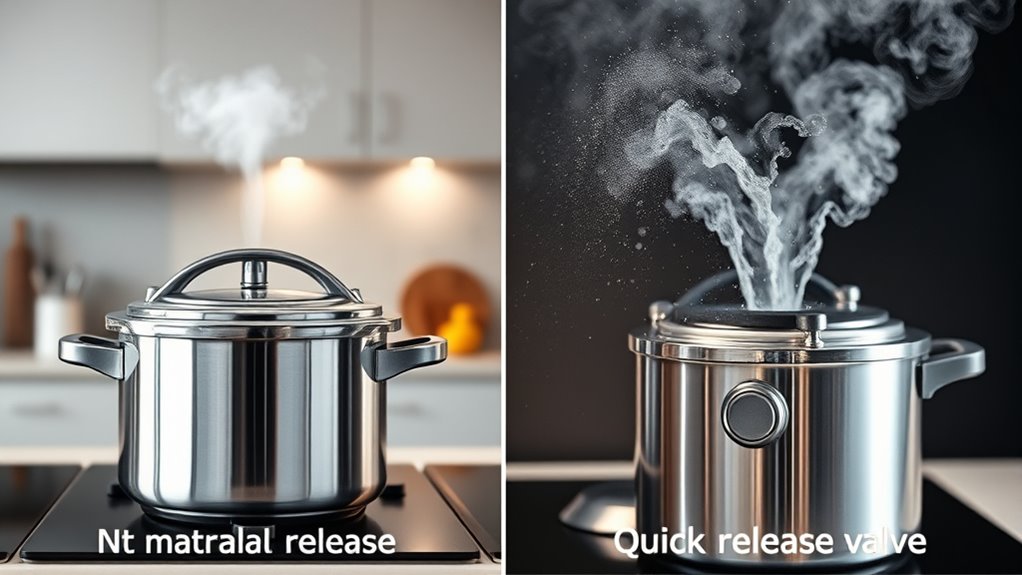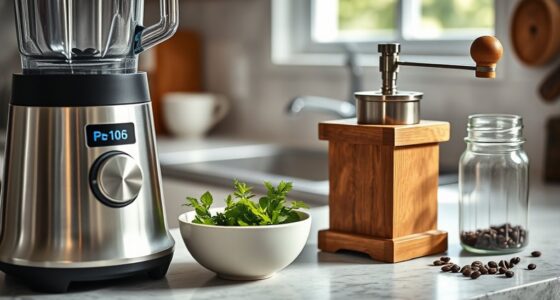Use natural release when cooking delicate foods or dishes that need gentle finishing, like rice, beans, or braised meats, to preserve flavor and texture while ensuring safety. Opt for quick release when you’re in a hurry or cooking quick-cooking ingredients such as vegetables or seafood, to prevent overcooking and mushiness. Knowing when to choose each method can improve your results and safety—keep exploring for more tips on mastering your pressure cooker.
Key Takeaways
- Use natural release for delicate foods, to prevent overcooking and preserve texture and flavor.
- Opt for quick release when cooking quick-cooking ingredients or in a hurry to prevent overcooking.
- Choose natural release for dishes like stews and tough meats to enhance tenderness and flavor retention.
- Use quick release for vegetables and seafood to avoid mushiness and maintain freshness.
- Prioritize natural release for safety and control, especially with foods that release a lot of steam or foam.

When using a pressure cooker, choosing between natural and quick release methods can considerably affect your meal’s texture and flavor. This decision isn’t just about convenience—it also impacts cooking safety and how well flavors are retained. Natural release involves turning off the heat and letting the pressure decrease gradually on its own, which can take several minutes. Quick release, on the other hand, involves manually opening the valve to release steam immediately, drastically reducing cooking time.
From a safety perspective, natural release is often considered safer because it prevents sudden steam bursts that could cause burns or splatters. It allows the pressure to subside slowly, giving you more control and reducing the risk of accidents. When cooking delicate foods like rice, beans, or tough cuts of meat, natural release helps prevent overcooking and keeps the ingredients intact. It also minimizes the risk of hot liquid splattering, making it a safer choice for many recipes.
Natural release enhances safety by preventing steam bursts, reducing accidents, and protecting delicate ingredients from overcooking.
Flavor retention is another critical factor when choosing between the two methods. Natural release tends to preserve more of the food’s natural juices and flavors because it allows the ingredients to finish cooking gently and evenly. This slow depressurization prevents rapid temperature changes that might cause flavors to escape with the steam. As a result, dishes like stews or braised meats often taste richer and more developed when you opt for natural release.
Additionally, natural release can help manage pressure levels more effectively, which is essential for a safe and controlled cooking process. Quick release is beneficial when you’re in a hurry or cooking foods that can turn mushy if overexposed to heat. It’s especially useful for vegetables or seafood, which can lose their texture and flavor if cooked too long. However, quick release can sometimes cause a small amount of hot liquid to spray out, so it’s essential to carefully manage the valve and avoid overfilling the cooker. Also, some recipes specify that quick release might lead to less flavor retention because the rapid pressure drop can cause some of the aromatic compounds to escape with the steam.
Frequently Asked Questions
Can I Switch Between Natural and Quick Release Mid-Cooking?
You shouldn’t switch between natural and quick release mid-cooking, as it can influence cooking safety and recipe outcomes. Once you’ve started with one method, stick to it to ensure proper pressure stabilization and avoid accidents. If you need to modify your recipe, it’s best to plan ahead and choose the release method accordingly. Doing so helps prevent overcooking or undercooking and keeps your cooking process safe and predictable.
How Does Altitude Affect Pressure Release Methods?
Altitude affects pressure release methods because higher elevations require altitude adjustment for proper pressure regulation. When cooking at high altitudes, you should prefer natural release to prevent sudden pressure drops that could affect food texture and safety. The increased atmospheric pressure at lower elevations allows quick release without issues. Always adjust your pressure cooker settings and release method based on your altitude, ensuring safe and effective cooking outcomes.
Are There Foods That Shouldn’t Be Quick Released?
You should avoid quick releasing pressure for foods like beans, grains, and dense meats because rapid pressure buildup can cause splattering or even dangerous hot liquid eruptions. Scientific studies suggest that certain foods release pressure differently, so follow safety precautions. For these items, a natural release allows gradual pressure reduction, preventing accidents and preserving food texture. Always consider the food’s nature and manufacturer’s instructions to guarantee safe, effective pressure release.
Does Pressure Release Method Impact Food Texture?
Yes, the pressure release method impacts food texture. Quick release can cause foods like pasta and delicate vegetables to become mushy or overcooked due to rapid pressure drop, while natural release helps preserve texture by allowing gradual pressure reduction. If you want to maintain your dish’s original consistency, choose the method that offers better pressure impact control. Quick release is ideal for preventing overcooking, especially with sensitive ingredients.
How Long Does Each Release Method Take?
A watched pot never boils, but when it comes to pressure release, timing varies. Natural release takes about 10 to 30 minutes, depending on the recipe and pressure level, as it slowly lets pressure escape. Quick release happens instantly—within a minute or two—by releasing the valve. Your choice affects cooking times and convenience, so consider your dish’s needs and desired texture before choosing the release speed.
Conclusion
Choosing between natural and quick release depends on your dish. Natural release allows flavors to deepen and prevents splatters, making it ideal for tougher cuts and grains. Quick release is perfect when you need to prevent overcooking, like with delicate vegetables. Did you know that nearly 60% of pressure cooker users prefer natural release for stews? Understanding when to use each method guarantees perfectly cooked meals and enhances your culinary skills every time.









